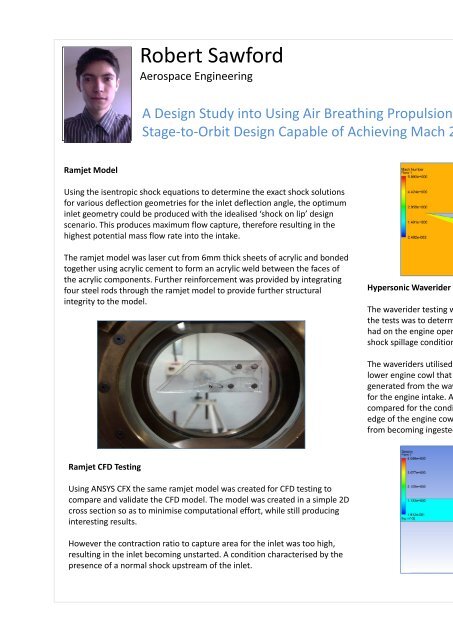UWE Bristol Engineering showcase 2015
Create successful ePaper yourself
Turn your PDF publications into a flip-book with our unique Google optimized e-Paper software.
Ramjet Model<br />
Robert Sawford<br />
Aerospace <strong>Engineering</strong><br />
Using the isentropic shock equations to determine the exact shock solutions<br />
for various deflection geometries for the inlet deflection angle, the optimum<br />
inlet geometry could be produced with the idealised ‘shock on lip’ design<br />
scenario. This produces maximum flow capture, therefore resulting in the<br />
highest potential mass flow rate into the intake.<br />
The ramjet model was laser cut from 6mm thick sheets of acrylic and bonded<br />
together using acrylic cement to form an acrylic weld between the faces of<br />
the acrylic components. Further reinforcement was provided by integrating<br />
four steel rods through the ramjet model to provide further structural<br />
integrity to the model.<br />
Ramjet CFD Testing<br />
A Design Study into Using Air Breathing Propulsion to Produce a Single-<br />
Stage-to-Orbit Design Capable of Achieving Mach 25<br />
Using ANSYS CFX the same ramjet model was created for CFD testing to<br />
compare and validate the CFD model. The model was created in a simple 2D<br />
cross section so as to minimise computational effort, while still producing<br />
interesting results.<br />
However the contraction ratio to capture area for the inlet was too high,<br />
resulting in the inlet becoming unstarted. A condition characterised by the<br />
presence of a normal shock upstream of the inlet.<br />
Hypersonic Waverider Testing<br />
The waverider testing was conducted at Mach 3.0 and Mach 5.0. the goal of<br />
the tests was to determine the effect of different leading edge wedge angles<br />
had on the engine operation, as well as assessing the performance under<br />
shock spillage conditions and shock ingestion.<br />
The waveriders utilised variable inlet geometry in the form of an extending<br />
lower engine cowl that would be able to catch the leading edge shock<br />
generated from the waverider body, thus producing maximum flow capture<br />
for the engine intake. Additionally the performance was assessed and<br />
compared for the condition whereby the flow is allowed to spill over the<br />
edge of the engine cowl, reducing shock capture but preventing the shocks<br />
from becoming ingested.<br />
Project Supervisor<br />
Dr Chris Toomer<br />
Project summary<br />
A ramjet model was designed and<br />
manufactured for testing in the supersonic<br />
wind tunnel. The model was used for<br />
comparison and validation of the same<br />
simulated test using ANSYS CFX. Furthermore<br />
the project transitioned into testing various<br />
waverider designs with variable inlet<br />
geometry under a variety of inlet conditions<br />
at different Mach numbers.<br />
Project Objectives<br />
To design and asses the engine performance<br />
of a ramjet scramjet propelled hypersonic<br />
waverider through various Mach regimes up<br />
to Mach 25.<br />
Project Conclusion<br />
The use of acrylic as the primary material for the ramjet<br />
model proved to be too fragile. The laser cutter distorted<br />
the geometry around the leading edges, partially melting<br />
the acrylic and thus making it brittle. Future models will<br />
utilise CNC milled inlet geometry sandwiched between<br />
acrylic panels, increasing robustness while still allowing<br />
the internal shock structure to be visualised.<br />
From the hypersonic and high supersonic testing of<br />
the waverider designs, the numerical accuracy of the<br />
solutions around areas of high changes in state and<br />
energy is lower than is required for a CFD solution<br />
that industry can use to supplement physical testing.<br />
However the structure of the oblique shocks,<br />
compression and nozzle behaviour from the vehicle<br />
forebody as well as the expansion and shocks<br />
generated by the waveriders wake is displayed by the<br />
simulation, providing insight into the behaviour of the<br />
waverider at these Mach regimes. As outlined by<br />
Segal, running the inlet under spillage conditions<br />
produces a more stable combustion environment<br />
than when the shocks are ingested into the engine.<br />
However this more stable environment is created<br />
with the sacrifice of reduced compression, and as a<br />
consequence may not be sufficient to produce the<br />
thrust requirements for accelerating into higher<br />
hypersonic Mach regimes.


